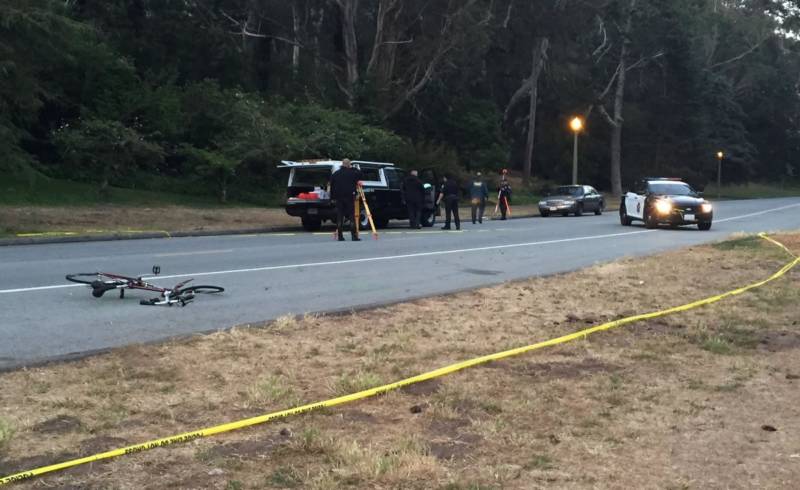“This list is a short list of the many projects that we’re working on,” Reiskin said. “What was new was our commitment to reach the milestones that we identified on this list by the end of 2017.”
McCarthy was among dozens of bicyclists and advocates who packed Thursday’s Vision Zero committee meeting at City Hall to share their frustration with what they see as a lack of action on the part of city officials to protect bicyclists and pedestrians.
Sunset District resident Elisabeth Snider told the committee she's worried about the safety of cycling in Golden Gate Park, where Heather Miller was killed last week and where Snider regularly rides with her three young children.
“Even on the marked bike routes, there’s no enforcement,” Snider said. “Cars speed, they do not give right of way where the sharrows are. It is extremely dangerous to bike through the park.”
Nicole Ferrara, executive director of Walk San Francisco, pointed out that more than a quarter of the way to Vision Zero’s 2024 goal of zero traffic deaths, there has been no reduction.
City data show there were 31 traffic fatalities in each of the past two calendar years since Vision Zero was announced and 19 deaths so far this year.
The 81 total deaths recorded on city streets since the program started include 50 pedestrians, 11 motorcyclists, nine bicyclists, six motor vehicle passengers and five drivers. The tally doesn't include 16 deaths that have occurred on freeways in the city.
“It’s depressing, it’s really depressing,” Ferrara said. “It has to be also a call to action and re-initiate that sense of urgency because we know these crashes are preventable, and we know we can do something to change them.”
Ferrara called for San Francisco to adopt automated speed enforcement -- better known as speed cameras -- which would allow the city to more effectively detect and cite speeding cars.
Current state law bans the cameras, and identifying state legislators who would back a statute allowing the devices is one of the 57 “high-priority projects” Mayor Lee announced Thursday.
At the Vision Zero meeting, Supervisor Jane Kim asked the SFMTA’s director of sustainable streets, Tom Maguire, if the city could implement speed cameras without waiting for state approval.
“Can we be creative about thinking about these cameras to change behavior because we know that SFMTA and SFPD just simply cannot be at all the high-injury corridors 24/7?” Kim asked.
Maguire said that the SFMTA is working with the city attorney to investigate that possibility.
Kim mentioned San Francisco’s history of defying state laws when they come up against city values, such as same-sex marriage.
“I’m just getting tired of waiting,” Kim said. “I feel like at a certain point we have to stand up and say we’re going to do this because it’s the right thing to do, and if the state is not ready to save lives in our city then we’re going to do it and challenge state law on that.”
On Friday's "Forum," Reiskin said the city was working on state legislation that would authorize San Francisco to implement a limited automated speed enforcement program tailored to answer concerns that such systems invade motorist privacy and may be little more than a revenue grab.
He said the program would focus on vehicle license plates, not drivers, with fines of no more than $100. Citations would not be issued unless a vehicle is traveling at least 10 mph above posted speed limits. And drivers would not be penalized with points on their driving records for the San Francisco speed citations.
"We're hearing the concerns, trying to address them, trying to work with folks in the Legislature and other stakeholders to get this through," Reiskin said.
Protected bike lanes have been one of the biggest demands of bike advocates, and Maguire touted the 13 miles of protected bike lanes that have been built since 2010. He said the agency’s bike program is re-evaluating the $90 million set aside for bicycle improvements in the five-year capital plan to see if protected bike lanes are the best tool for increasing safety.
A handful of the 57 high-priority projects involve protected bike lanes, but McCarthy said on "Forum" that it’s not enough. She specifically mentioned the lack of a planning for a protected bike lane on Golden Gate Park's John F. Kennedy Drive, where Miller was killed.
“We’re trying not to chase necessarily the last incident but to focus on the ones we know that are of the highest priority,” Reiskin said. He also cited engineering concerns and limited funding as other barriers to building more protected bike lanes.
In addition to infrastructure projects, the SFMTA is focusing on increased education and enforcement efforts to help reduce traffic deaths. These include “targeted local messaging” on speeding this summer, a major media push in September and 130 hours a week of targeted speeding enforcement by SFPD in October.
Supervisor Norman Yee said Thursday he wants to hear more about education initiatives at the next Vision Zero committee meeting, and Supervisor John Avalos voiced concern that current education efforts aren’t cutting it.
